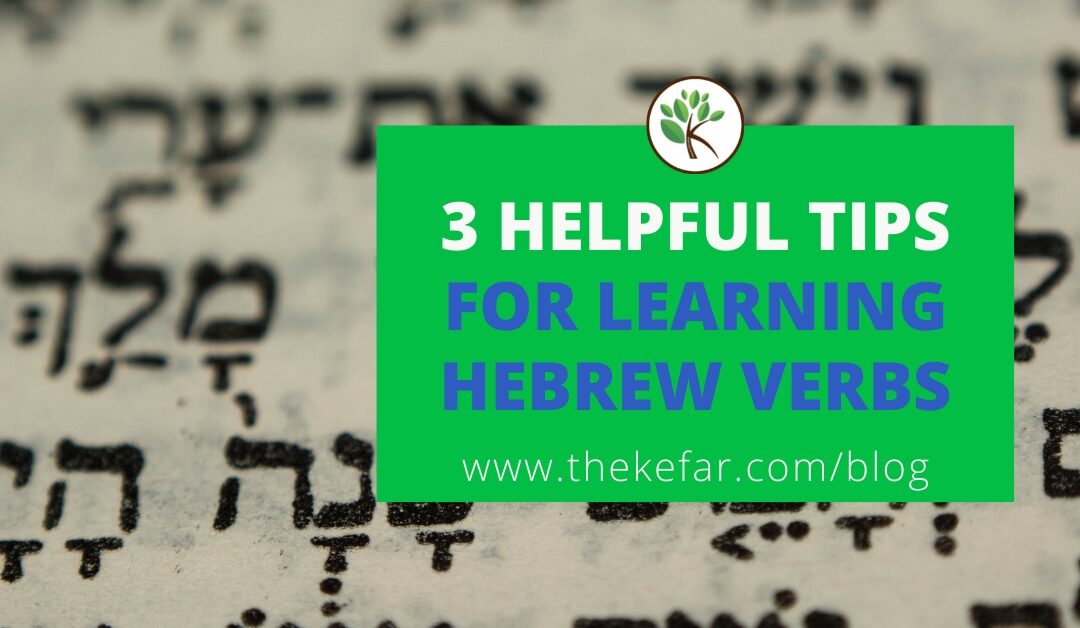Over the past few weeks, our daily everyday Hebrew Sentence Series have focused on wearing a mask, washing your hands, and making a peanut butter & jelly sandwich in Hebrew. If you’re new here – welcome! – check out the first review post here. Before we get into the notes and exercises, I want to review the point of the everyday Hebrew sentence lessons is – and I’ll start by saying what the point isn’t.
The goal of these everyday Hebrew sentences is NOT to tell you how to do things like wear a mask or read a book. I can’t tell you the number of “bUt mAsKs aRe EviL” comments I got from folks who were so fixated on not wanting to wear a mask that they missed the whole point – which is the language itself.
These sentence videos help you learn Hebrew words and phrases that you can use in everyday Hebrew conversation. The way the Hebrew sentences are presented varies each week to focus on a particular action, and that’s to help you learn the language in context. The context helps you learn Hebrew sentence structure, what prepositions to use with what verbs, what verb conjugations to use, the genders of nouns, and so much more. You’re learning to actually use the words, instead of being caught up in grammar and mechanics.
As you watch the videos moving forward, don’t get bogged down by the details of the actions themselves. If you don’t eat peanut butter (I don’t either – yuck), that’s fine, you still know how to say “spread on,” in Hebrew and you can use it to spread butter, jelly, mayonnaise, hummus, or whatever else you might want to spread instead. Maybe you don’t cut your sandwiches in half, but you know the word for “cut” in Hebrew, and you can use that to talk about cutting anything. So on and so forth….
Sounds good? Yes? Perfect! So, BO’U NATCHIL בואו נתחיל – let’s get started!
Hebrew Verb Notes
Before reading, consider your answers to the following questions:
1. The verbs CHOTECH/CHOTECHET חותך/חותכת and SHOTEF/SHOTEFET שוטף/שוטפת have the same conjugation patterns as two of the Hebrew verbs from the first review – which two?
2. The verb MOREACH/MORACHAT מורח/מורחת has the same conjugation pattern as two of the Hebrew verbs from the last review – which two? What do all of these verbs have in common? (Hint: look at the letters used in each.)
3. Feminine singular verbs end in one of two ways: what are they?
🔵 There were a good number of verbs in the last three everyday Hebrew sentence series – 12 to be exact. Let’s look at a few and group them with the verbs you’ve already learned from the previous set of Hebrew videos:
🟢 The infinitive is the “to” form of the verb, as in “to watch,” “to run,” or “to sleep.” Verb infinitives in Hebrew start with the letter Lamed . There were two infinitive Hebrew verbs: LEHAGEN להגן (to protect), and LAATOT לעטות (to wear**).
** There are several verbs in Hebrew that mean “to wear,” and the one you use depends on what it is that you’re wearing. LAATOT לעטות is the verb we use when wearing/putting on a mask.
🔵 We also had the conjugations of LAATOT לעטות, which were OTEH עוטֶה (m) and OTAH עוטָה (f). So “she wears a mask” is HEE OTAH MASECHAH היא עוטה מסכה, but “she wants to wear a mask” would be HEE ROTSAH LAATOT MASECHAH” היא רוצה לעטות מסכה.
🟢 Singular feminine Hebrew verbs either end in the letter TAV ת (either “ET” like MESHAFSHEFET משפשפת or “AT” like MORACHAT מורחת), or in the letter HEY ה (“AH” as in SAMAH שמה and MOSIFAH מוסיפה). The endings – ET, AT, or AH, are added to the singular masculine forms of Hebrew verbs.
🔵 The verbs SHOTEF/SHOTEFET שוטף/שוטפת and CHOTECH/CHOTECHET חותך/חותכת, have the exact same conjugation pattern as the verbs SOGER/SOGERET סוגר/סוגרת and KOTEV/KOTEVET כותב/כותבת. Say the verbs aloud and notice how the vowel sounds are the same for both the masculine (o-e) and feminine (o-e-et) conjugations.
🟢 The verb MOREACH/MORACHAT מורח/מורחת has the exact same conjugation pattern as the verbs POTEACH/POTACHAT פותח/פותחת and LOKEACH/LOKACHAT לוקח/לוקחת. Say the verbs aloud and notice how the vowel sounds are the same for both the masculine (o-e-a) and feminine (o-a-at) conjugations.
🔵 When you watch future Hebrew sentence videos, continue to pay attention to the verb sound patterns, and see which ones sound like verbs you already know.
Hebrew Verbs Exercises
Match each Hebrew verb on the left with the word or phrase that you would use the verb with. For example, “…a book” would match with “KORE/KORET קורא/קוראת.”
Select the correct translations of each Hebrew verb in this second exercise.
Hebrew Pronoun Notes
🔵 At this point, you’ve learned the singular pronouns in Hebrew: I, you (m and f), he, and she. A good phrase to remember is “HU is he and HEE is she.” It’ll remind you that HU הוא in Hebrew means “he” in English, and HEE היא in Hebrew means “she” in English.
🟢 Hebrew doesn’t have any words for “am,” “is,” or “are,” so “he is putting,” for example, is just HU SAM הוא שם – “he” and “puts/putting.”
🔵 The Hebrew pronoun ZO זו means “it,” “this,” and “that,” and it’s feminine. There’s another feminine word that means the same thing and sounds similarly, and that word is ZOT זאת. So both ZOT זאת and ZO זו have the same meaning. The masculine form is ZEH זה. So ZEH זה is the masculine it/this/that, and ZO זו and ZOT זאת are the feminine it/this/that.
Exercise 2: Review Hebrew Pronouns
In this exercise below, you’re going to match the correct Hebrew pronoun to the subject in each sentence.
Additional Hebrew Grammar Notes
🔵 Peanut butter in Hebrew is literally “butter of peanuts,” and it’s created by putting those two nouns together. The word for butter is CHEM’AH חמאה, and the word for peanuts is BATNIM בטנים. When we put these two nouns together, the final letter Hey ה of the first noun – CHEM’AH חמאה – changes to a Tav ת. This makes it CHEM’AT BATNIM חמאת בטנים instead of CHEM’AH. This is called a construct chain in Hebrew, and you can watch this video to learn more.
🟢 As a general rule (although there are more than a few exceptions), plural masculine nouns in Hebrew will end in -IM, as in SFARIM ספרים (books) and BATNIM בטנים (peanuts). Plural feminine nouns in Hebrew generally will end in -OT, as in PRUSOT פרוסות (slices) and SHNIYOT שניות (seconds). There are exceptions though – MEKOMOT מקומות (places) is in fact a masculine noun, although it ends in -OT, and YADAYIM ידיים (hands) is a feminine noun, although it ends in IM.
🔵 When it comes to Hebrew verbs and adjectives, though, the masculine and feminine plural endings are always consistent. This means that if a Hebrew verb or adjective ends in IM, it’s definitely plural and masculine. It it ends in -OT, it’s definitely plural and feminine. We’ll talk more about this in the future when we have plural examples in the videos.
Exercise 3: Hebrew Listening Comprehension
In this exercise, you will hear Hebrew sentences that use words from the everyday Hebrew sentence series 4-6. Translate each Hebrew sentence into English.
DISCLAIMER: I could only input one correct option, even though you might be able to translate the sentence correctly in a number of ways. For example, הִיא מַחֲזִירָה אֶת הָעֵט could correctly be translated as: (1) She puts the pen back (2) She returns the pen (3) She puts back the pen (4) She is putting back the pen (5) She is putting the pen back or (6) She is returning the pen. If I put in option 1, but you typed in any of the other choices, the system will mark it as incorrect, but you go ahead and give yourself those points anyway!
To try and keep it simple, all of the answers are in the simple present (i.e. you write, I close).
Exercise 4: Final Review Quiz
Do you still have questions about the lessons from the last three everyday Hebrew sentence series (wearing a mask, washing hands, and making a PB&J)? If so, let me know what you’re still wondering about in the comments!
Zehu זהו – that’s all folks!
I hope you enjoyed these Hebrew exercises and found them helpful, and make sure you’re subscribed to my channel so you don’t miss a single sentence!
Until next time,


3 Tips to Learn Hebrew Verbs
Today I want to share with you three tried and true tips to help you learn Hebrew verbs, and...

